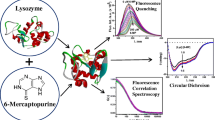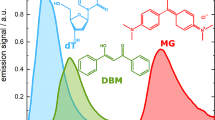Abstract
The fluorescence lifetime and rotational correlation time of the tryptophan residue in melittin, as both a monomer and tetramer, have been measured between pH 6 and 11. The fluorescence decays are non-exponential and give lifetimes of 0.7±0.1 ns and 3.1±0.1 ns. This emission is consistent with a model in which the tryptophan residue is in slightly different environments in the protein. In a dilute solution of monomer the mean fluorescence lifetime is 2.3±0.1 ns, below pH 10, but falls to 1.7 ns at higher pH. In contrast, the melittin tetramer has a mean fluorescence lifetime of only 2.2 ns at pH 6, which falls to 1.9 ns by pH 8, and falls again above pH 10 to the same value as in monomeric melittin. The behaviour between pH 6 and 8 is explained as the quenching of the Trp residue by lysine groups, which are near to the Trp in the tetramer but in the monomer, are too distant to quench. Fluorescence anisotropy decays show that the Trp residue has considerable freedom of motion and the range of “wobbling” motion is 35±10° in the tetramer
Similar content being viewed by others
References
Barkley M, Zimm B (1979) Theory of twisting and bending of chain macromolecules: Analysis of fluorescence depolarisation of DNA. J Chem Phys 70:2991
Beddard G, Tran C (1985) Fluorescence studies of the restricted motion of tryptophan in α-Cobratoxin. Eur Biophys J 11:243
Beddard G, Fleming G, Porter G, Robbins R (1980) Time resolved fluorescence from biological systems: Tryptophan and simple peptides. Philos Trans R Soc (London) Ser A 298:321
Bello J, Bello H, Granados E (1982) Conformation and aggregation of Melittin: dependence of pH and concentration. Biochemistry 21:461
Brown L, Lauterwein J, Wuthrich K (1980) High resolution proton NMR studies of self aggregation of Melittin in aqueous solution: Biochim Biophys Acta 622:219;622:321
Burstein EA, Vedenkina NS, Ivkova MN (1973) Fluorescence and the location of tryptophan residues in protein molecules. Photochem Photobiol 18:263
Dawson C, Drake A, Helliwell J, Hider R (1978) The interaction of Bee Melittin with lipid bilayer membranes. Biochim Biophys Acta 510:75
Faucon J, Dufourcq J, Lussan L (1979) The self-association of Melittin and its binding to lipids: an intrinsic fluorescence polarisation study. FEBS Lett 102:187
Georghiou S, Thompson M, Mukhopadhyay A (1981) Melittin phospholipid interaction, evidence for melittin aggregation. Biochim Biophys Acta 642:429
King T, Sobotka A, Kachoumian L, Lichtenstein L (1976) Allergens of honey bee venom. Arch Biochem Biophys 172:661
Kinosita R, Kawato S, Ikegami A (1977) A theory of fluorescence polarisation in membranes. Biophys J 20:289
Knoeppel E, Eisenberg D, Wickner W (1979) Interactions of Melittin, a pre-protein model with detergents. Biochemistry 18:4177
Lakowicz J, Maliwal B, Cherek H, Balter A (1983) Rotational freedom of tryptophan residues in proteins and peptides. Biochemistry 22:1741
Munro I, Pecht I, Stryer L (1979) Subnanosecond motions of tryptophan residues in proteins. Proc Natl Acad Sci (USA) 76:56
Quay S, Condie C (1983) Conformational studies of aqueous melittin: Thermodynamic parameters of the monomertetramer self-association reaction. Biochemistry 22:695
Quay S, Tronson L (1983) Conformational studies of aqueous melittin: determination of ionisation constants of lysine-21 and lysine-23 by reactivity towards 2,4,6-trinitrobenzenesulphonate. Biochemistry 22:700
Rigler R, Ehrenberg M (1973) Molecular interactions and structure as analysed by fluorescence relaxation spectroscopy. Q Rev Biophys 6, 2:139
Smith G, Thorpe M, Melhuish W, Beddard G (1980) Fluorescence from tryptophan in keratin. Photochem Photobiol 32:715
Talbot J, Dufourcq J, DeBohy J, Faucon J, Lussan A (1979) Conformational change and self-association of melittin. FEBS Lett 102:191
Terwilliger T, Weissman L, Eisenberg D (1982) The structure of melittin in the form 1 crystals and its implication for melittins lytic and surface activities. Biophys J 37:353
Tran C, Beddard G (1982) Secondary structure and dynamics of glucagon in solution. Biochim Biophys Acta 709:256
Author information
Authors and Affiliations
Rights and permissions
About this article
Cite this article
Tran, C.D., Beddard, G.S. Studies of the fluorescence from tryptophan in melittin. Eur Biophys J 13, 59–64 (1985). https://doi.org/10.1007/BF00266310
Accepted:
Issue Date:
DOI: https://doi.org/10.1007/BF00266310




